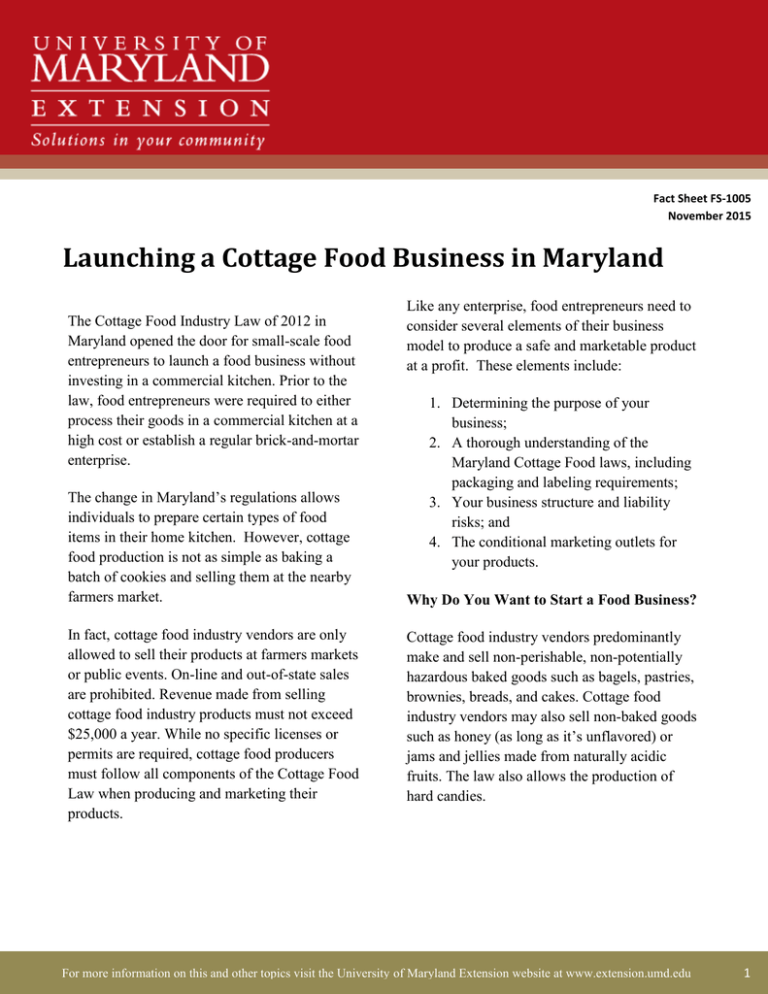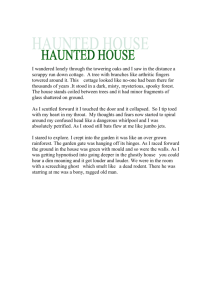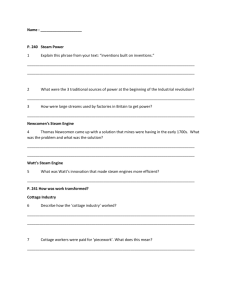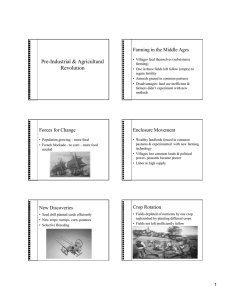Launching a Cottage Food Business in Maryland
advertisement

Fact Sheet FS-1005 November 2015 Launching a Cottage Food Business in Maryland The Cottage Food Industry Law of 2012 in Maryland opened the door for small-scale food entrepreneurs to launch a food business without investing in a commercial kitchen. Prior to the law, food entrepreneurs were required to either process their goods in a commercial kitchen at a high cost or establish a regular brick-and-mortar enterprise. The change in Maryland’s regulations allows individuals to prepare certain types of food items in their home kitchen. However, cottage food production is not as simple as baking a batch of cookies and selling them at the nearby farmers market. In fact, cottage food industry vendors are only allowed to sell their products at farmers markets or public events. On-line and out-of-state sales are prohibited. Revenue made from selling cottage food industry products must not exceed $25,000 a year. While no specific licenses or permits are required, cottage food producers must follow all components of the Cottage Food Law when producing and marketing their products. Like any enterprise, food entrepreneurs need to consider several elements of their business model to produce a safe and marketable product at a profit. These elements include: 1. Determining the purpose of your business; 2. A thorough understanding of the Maryland Cottage Food laws, including packaging and labeling requirements; 3. Your business structure and liability risks; and 4. The conditional marketing outlets for your products. Why Do You Want to Start a Food Business? Cottage food industry vendors predominantly make and sell non-perishable, non-potentially hazardous baked goods such as bagels, pastries, brownies, breads, and cakes. Cottage food industry vendors may also sell non-baked goods such as honey (as long as it’s unflavored) or jams and jellies made from naturally acidic fruits. The law also allows the production of hard candies. For more information on this and other topics visit the University of Maryland Extension website at www.extension.umd.edu 1 If you have expertise in baking, candy-making or canning and want to start a food cottage business, every entrepreneur will tell you that you need to be passionate about your product to attract and retain customers. Do you take pleasure in baking a beautiful wedding cake or making jars of jams and jellies in unique and enticing flavors? As a cottage food industry, Always check the posting or publication date of the regulations referenced to be sure they are the most current listings. Regulations are often revised or updated to meet retail and health department regulations. most of your sales will be one-on-one directly to customers. The law does not allow cottage food vendors to sell to retail stores or wholesale distributors. Understanding the Parameters of Maryland Cottage Food Industry Law The Cottage Food Industry Law of 2012 sets forth the following production and labeling requirements: Production Specifications Cottage food producers: 1. Are not exempt from Federal or State taxes (including, but not limited to, sales tax). 2. Must produce or package their cottage food products in a residential kitchen. 3. Must have annual revenues from sales not exceeding $25,000. 4. May only sell cottage food products that were stored on the premises of the cottage food business; may be sold only at bake sales (in conjunction with a non-profit fundraiser), farmer’s markets, or public events. 5. May only sell cottage food that is properly labeled (see labeling requirements). 6. Must comply with all applicable county and municipal laws and ordinances regulating the preparation, processing, storage, and sale of cottage food (must obtain home‐use/occupation permits through the county). 7. Must allow the Maryland Department of Health and Mental Hygiene access to the kitchen to investigate complaints of violations of the cottage food laws and regulations; the owner may not refuse to grant access or interfere with any inspection; investigation of a cottage food business may include sampling of products to determine misbranding or adulteration; the Maryland Department of Health and Mental Hygiene may enforce any regulations adopted under the cottage food statutes; any foods produced in violation may be deemed an unapproved source. Labeling Requirements: Food labelling laws ensure consumers get vital information about the foods they consume. For more information on this and other topics visit the University of Maryland Extension website at www.extension.umd.edu 2 It is very important that you label your products correctly. All cottage food products must contain a label that includes the following information: 1. The name and address of the cottage food production operation. 2. The name of the food product, such as “Chocolate Chip Cookies.” 3. The ingredients of the food product, in descending order of predominance by weight. This means your heaviest ingredient will be listed first and the lightest ingredient listed last. Ingredients must be broken down completely if the ingredient itself contains two or more ingredients. For example, if unsalted butter is one of your ingredients, then you would list it as: Butter (Sweet Cream, Natural Flavor). 4. The net quantity of contents in both the U.S. Customary System (inch/pound) and International System of Units (metric system). This must be placed within the lower 30% of the label in a line parallel to the bottom of the package. An example of what this would look like in both the U.S. Customary System and International System is: This statement is required because it gives notice to the purchaser of the food product that the product was produced in a private home that is exempt from inspection by a food regulatory authority. 6. Allergen Statement. There are eight foods considered to be major food allergens under the Food Allergen Labeling and Consumer Protection Act. If your product contains any of these eight foods, they must be listed on your label: 1. Milk 2. Eggs 3. Fish –The specific species must be declared, such as bass. 4. Crustacean Shellfish –The specific species also must be declared; for example, crab. 5. Tree Nuts –The specific type of nut must be declared, such as almonds. 6. Wheat 7. Peanuts 8. Soybeans If any of these major allergens are contained in your food product, then you may declare them in either of two ways. Net Wt. 8 oz. (227 g) 5. If this product was made under the Maryland Cottage Food Law, the label must contain 10-point type: "Made by a cottage food business that is not subject to Maryland's food safety regulations." First, you can list the allergens in a “Contains” statement that would follow the ingredients list and look like this: “Contains: Wheat, Egg.” The second way to declare an allergen is in your ingredients list. An example would be: “Enriched flour (wheat flour, malted barley, niacin, reduced iron, thiamin mononitrate, riboflavin, folic acid), Egg.” In this example, For more information on this and other topics visit the University of Maryland Extension website at www.extension.umd.edu 3 wheat and egg are specifically stated within the ingredients so you would not need to put an additional “Contains” statement. Here is a sample label from http://forrager.com/law/maryland/ Chocolate Chip Cookies Made by a cottage food business that is not subject to Maryland's food safety regulations. (10-point type) Forrager Cookie Company 123 Chewy Way, Cookietown, MD 73531 Ingredients: enriched flour (wheat flour, malted barley flour, niacin, iron, thiamin mononitrate, riboflavin, folic acid), butter (cream, salt), semi-sweet chocolate (sugar, chocolate, cocoa butter, milkfat, soy lecithin, natural flavors), brown sugar, granulated sugar, eggs, vanilla extract (vanilla bean extract, alcohol, sugar), baking soda, salt (salt, calcium silicate) Contains: milk, eggs, wheat, soy NET WT. 1 lb. 4 oz. (1.02 kg) The U.S. Food and Drug Administration website also provides great resources for guidance on food labeling: http://www.fda.gov/Food/GuidanceRegulation/ GuidanceDocumentsRegulatoryInformation/Lab elingNutrition/ucm064880.htm Approved and Unapproved Foods Table 1 provides a breakdown of several different types of approved cottage industry products, the requirements for selling them through various outlets, and regulations regarding limits on revenues and sales. The $40,000 sales limit refers to approved products that can be sold in venues beyond farmer’s markets and special events. The annual revenue ceiling for cottage foods in Maryland is $25,000. Unapproved Foods for Cottage Production in Maryland: 1. Any natural or synthetic food that requires temperature control because the food is in a form capable of supporting the rapid and progressive growth of infectious or toxigenic microorganisms, the growth and toxin production of Clostridium botulinum, or, in raw shell eggs, the growth of Salmonella enteritidis. 2. A food of animal origin that is raw or heat-treated. 3. A food of plant origin that is heattreated. 4. Raw seed sprouts. 5. Cut melons. 6. Cut raw tomatoes. 7. Garlic and oil mixtures that support the rapid and progressive growth of infectious or toxigenic microorganisms or the growth and toxin production of Clostridium botulism. 8. Cut leafy greens. 9. Chocolates, caramel, fudge, and other soft candy. Making Your Business a Success While you may love to produce your product, remember that you’ll also need to manage the day-to-day operations of your business. Simply because the law allows you to do business does For more information on this and other topics visit the University of Maryland Extension website at www.extension.umd.edu 4 not mean you are exempt from running your business in a prudent and responsible way. Table 1. Approved cottage industry products, the requirements for selling them through various outlets, and regulations regarding limits on revenues and sales Type of Cottage Food Industry Product Baked goods Baked goods Examples of Product Non-potentially hazardous fillings or toppings such as pies, turnovers, fruit tarts, etc. No cream cheese, custards, or other potentially hazardous fillings, glazes, cream cheeses, etc. Potentially hazardous toppings that need to be refrigerated or stored such as cream cheese, custard based fillings, glazes, etc. Honey without any processing or additives. Licenses, Regulations, and Permit Requirements Can be sold at a market or from farmer without a license. Different regulations apply to selling to restaurants and/or if sales are over $40,000 per year. Processing License from Department of Health and Mental Hygiene (DHMH). Honey (with added flavors) Honey with flavors or other additional processing. No license required. Honey is considered a raw agricultural product. Processing license from DHMH Jams or jellies Made with level of 4.6 pH or less such as apples, apricots, blackberries peaches, strawberries, etc. No license required to sell directly at market. Different regulations apply to sell at restaurants. Honey (without added flavors) For more information on this and other topics visit the University of Maryland Extension website at www.extension.umd.edu 5 Here are suggested steps to follow when developing ideas about a food business: Need More Information? 1. Check with local municipality/county about zoning and any required business license. 2. Well or spring water must be tested for bacteria. This is not a concern if you are on a municipal water source. 3. Develop a specific idea about the product. This allows regulators to know your goal and it allows you to ask relevant questions. 4. Check with your insurance provider concerning product liability coverage. 5. Develop a written business plan to help guide your business’s growth. Lisa Staley Chief, Center for Facility and Process Review Office of Food Protection, Maryland Department of Health and Mental Hygiene lisa.staley@maryland.gov 410-767-8407 References Agnostelli, Gabriella. Cottage Food Laws and Liability: Protecting Your Home and Other Assets. November 28, 2012. http://www.foodlawfirm.com/2012/11/cottagefood-laws-and-liability-protecting-your-homeand-other-assets/ Niskanen, Sarah. Cottage Food Industry Vendor Information 101. April 1, 2014. http://www.marylandfma.org/cottage-foodindustry-vendor-information-101/ Maryland Cottage Law Fact Sheet. http://www.calverthealth.org/community/enviro nmentalhealthservices/PDF/cttgfdfs.pdf Maryland Cottage Food Industry. http://forrager.com/law/maryland/ Ginger S. Myers (gsmyers@umd.edu) This publication, Launching a Cottage Food Business in Maryland (FS-1005), is a series of publications of the University of Maryland Extension and Ag Marketing and the Maryland Rural Enterprise Development Center. The information presented has met UME peer review standards, including internal and external technical review. For more information on related publications and programs, visit: http://extension.umd.edu/agmarketing or http://extension.umd.edu/mredc . Please visit http://extension.umd.edu/ to find out more about Extension programs in Maryland. The University of Maryland, College of Agriculture and Natural Resources programs are open to all and will not discriminate against anyone because of race, age, sex, color, sexual orientation, physical or mental disability, religion, ancestry, or national origin, marital status, genetic information, or political affiliation, or gender identity and expression. For more information on this and other topics visit the University of Maryland Extension website at www.extension.umd.edu 6




